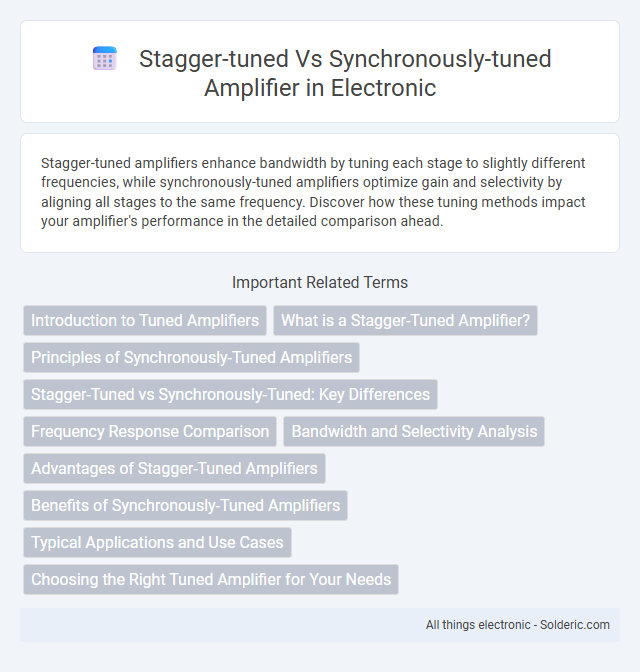Stagger-tuned amplifiers enhance bandwidth by tuning each stage to slightly different frequencies, while synchronously-tuned amplifiers optimize gain and selectivity by aligning all stages to the same frequency. Discover how these tuning methods impact your amplifier's performance in the detailed comparison ahead.
Comparison Table
| Feature | Stagger-Tuned Amplifier | Synchronously-Tuned Amplifier |
|---|---|---|
| Tuning Method | Multiple amplifier stages slightly detuned at different frequencies | All amplifier stages tuned to the same center frequency |
| Bandwidth | Wider overall bandwidth | Narrow bandwidth (sharper frequency response) |
| Gain Flatness | More uniform gain across the bandwidth | Higher gain at the center frequency with rapid roll-off |
| Frequency Response | Broader and smoother frequency response curve | Sharper and peak-centered frequency response |
| Design Complexity | More complex due to staggered tuning requirements | Simpler design, easier tuning |
| Applications | Wideband RF amplifiers, broadband receivers | Narrowband applications, selective RF amplification |
| Interstage Coupling | Careful design to maintain stagger tuning | Uniform coupling to maintain synchronous tuning |
Introduction to Tuned Amplifiers
Tuned amplifiers use resonant circuits to amplify signals at specific frequencies, enhancing selectivity and gain in RF applications. Stagger-tuned amplifiers achieve a broader bandwidth by slightly offsetting the resonant frequencies of cascaded stages, whereas synchronously-tuned amplifiers align all stages to the same resonance for maximum gain at a narrow frequency. Your choice between stagger-tuned and synchronously-tuned depends on the required balance between bandwidth and gain in high-frequency communication systems.
What is a Stagger-Tuned Amplifier?
A Stagger-Tuned Amplifier utilizes multiple amplifier stages, each tuned to slightly different frequencies to achieve a wider overall bandwidth and improved gain flatness compared to a Synchronously-Tuned Amplifier. This design minimizes the sharp peak in frequency response typical of synchronous tuning, resulting in better stability and reduced distortion in high-frequency applications. Understanding how your amplifier stages interact through stagger tuning can enhance the performance of RF communication systems and broadband signal processing.
Principles of Synchronously-Tuned Amplifiers
Synchronous-tuned amplifiers employ identical resonant frequencies in both the input and output circuits to maximize voltage gain and selectivity by reinforcing resonance effects. The principle involves precise tuning of coupled LC circuits to achieve high Q-factor resonance, resulting in improved bandwidth and stability compared to stagger-tuned amplifiers. This design reduces distortion and enhances frequency response, making synchronously-tuned amplifiers ideal for narrowband applications requiring high fidelity.
Stagger-Tuned vs Synchronously-Tuned: Key Differences
Stagger-tuned amplifiers use multiple stages with slightly offset resonant frequencies to achieve broader bandwidth and improved gain flatness, whereas synchronously-tuned amplifiers align all stages at the same resonant frequency for maximum gain at a narrower bandwidth. The stagger-tuned design offers better performance in wideband applications by reducing gain variation across frequency, while synchronously-tuned amplifiers excel in applications requiring high selectivity and peak gain. Your choice between these amplifier types depends on whether bandwidth or gain uniformity is the critical design requirement.
Frequency Response Comparison
Stagger-tuned amplifiers offer a wider and flatter frequency response by tuning each stage to slightly different frequencies, effectively broadening the overall bandwidth. Synchronously-tuned amplifiers, in contrast, synchronize all stages to the same resonant frequency, resulting in a sharp, high-gain peak but narrower bandwidth. Your choice between these designs impacts signal fidelity and application suitability, with stagger-tuned amplifiers favoring wideband amplification and synchronous tuning excelling in narrowband, high-selectivity scenarios.
Bandwidth and Selectivity Analysis
Stagger-tuned amplifiers use multiple amplifier stages tuned at slightly different frequencies to achieve a wider overall bandwidth, enhancing signal coverage with moderate selectivity. Synchronously-tuned amplifiers align all stages to the same frequency, resulting in higher selectivity and narrower bandwidth, ideal for rejecting adjacent channel interference. Your choice depends on whether broader bandwidth or sharper selectivity best suits your application's frequency response requirements.
Advantages of Stagger-Tuned Amplifiers
Stagger-tuned amplifiers offer improved bandwidth and better selectivity by using multiple amplifier stages tuned to slightly different frequencies, reducing the overall gain variation across a wider range. Their design helps in minimizing distortion and enhancing signal stability, making them ideal for applications requiring consistent amplification over a broad frequency spectrum. Your systems benefit from increased frequency response flexibility and reduced inter-stage coupling effects compared to synchronously-tuned amplifiers.
Benefits of Synchronously-Tuned Amplifiers
Synchronous tuning in amplifiers offers significant benefits including improved bandwidth and enhanced gain flatness compared to stagger-tuned amplifiers, making them ideal for wideband applications. These amplifiers achieve better selectivity and reduced distortion by simultaneously tuning multiple amplifier stages to the same frequency. The synchronous tuning also results in lower signal loss and higher overall efficiency, crucial for high-frequency communication systems.
Typical Applications and Use Cases
Stagger-tuned amplifiers are ideal for broadband applications such as wideband RF receivers and wideband communication systems due to their enhanced bandwidth and reduced distortion. Synchronously-tuned amplifiers excel in narrowband applications like RF power amplifiers and tuned radio frequency stages, where high gain and selectivity at a specific frequency are critical. Your choice depends on whether you prioritize wide frequency coverage with moderate gain or focused amplification with maximum gain and selectivity.
Choosing the Right Tuned Amplifier for Your Needs
Choosing the right tuned amplifier depends on your application's frequency response and gain requirements. Stagger-tuned amplifiers offer wider bandwidth by slightly offsetting resonant frequencies of each stage, ideal for broadband signals. Synchronously-tuned amplifiers provide higher gain and selectivity at a single frequency, making them suitable for narrowband applications requiring precise tuning.
Stagger-tuned vs Synchronously-tuned amplifier Infographic

 solderic.com
solderic.com